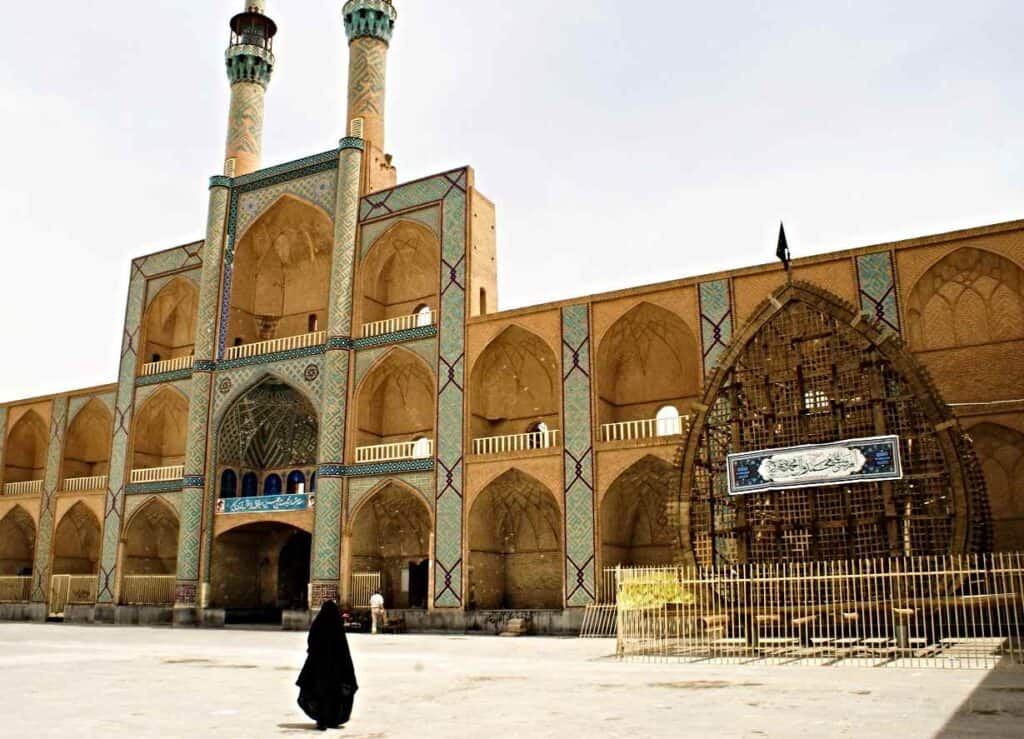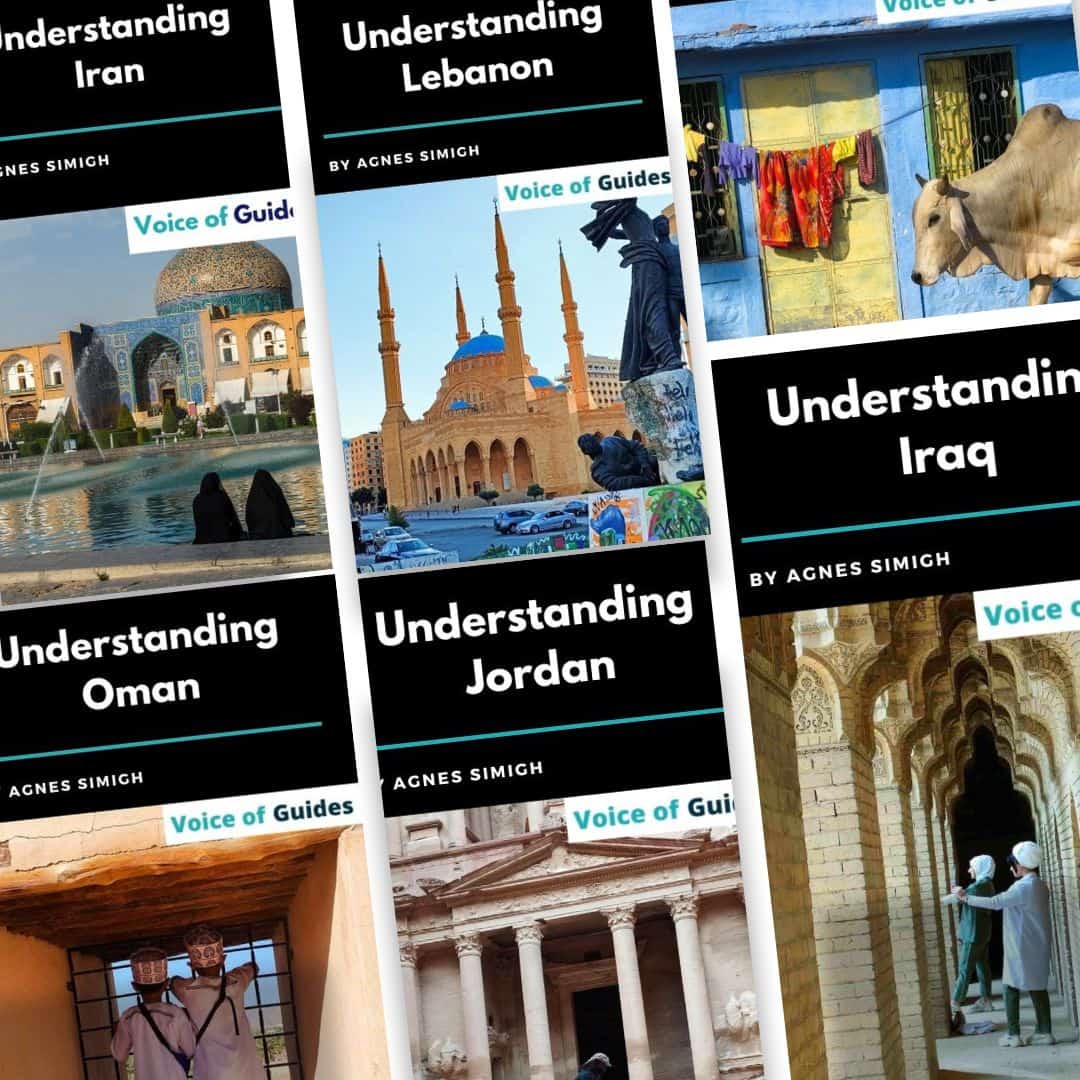The city of Yazd is one of the biggest cities built out of mudbrick, which remained almost entirely intact. Thanks to its remote location in the desert, it escaped all wars and attacks. Besides, Yazd has plenty of monuments related to the Zoroastrian religion. The cozy bazaars of Yazd, restaurants with terraces, cafés overlooking the city, and the choice of famous sweets (Baklava, Ardeh, Qottab, Loz, Pashmak) make it one of the most charming towns of Iran. This is a complete guide about the best places to visit and things to do in Yazd based on the suggestion of tour guides.
Where is Yazd?
Yazd lies geographically in the center, some 270 km southwest from Isfahan, and plays an essential cultural role in Iran.
How to go to Yazd from Tehran?
Bus: There are some daily buses from Tehran to Yazd. The distance between the two cities is 621 km and it takes approximately 7 hours by bus. There is also a night bus available from Tehran to Yazd.
Train: You can go from Tehran to Yazd by train (5 hours, 940 000- 1 400 000 IRR):
Check your schedule and ticket here: https://iranrail.net/
How to go from Isfahan to Yazd?
Bus: Yazd is 330 km from Isfahan, and it takes approximately 5 hours with a bus because it stops several times on the way. Buses leave every hour from 12:30 to 23:50. The price of a VIP bus is 340,000 IRR, for the ordinary buses is 230,000 IRR.
Train: There is a train from Isfahan to Yazd, but the railway station is on the outskirts. I recommend to take the bus.
Yazd, the religious city
The people of Yazd are known to have a deeply religious and family-centric culture. Yazd is the city with one of the lowest divorce rates in Iran. Work or money do not matter for local people. They appreciate more to have a pleasant life with the family instead. The Ashura celebrations in Yazd are the most spectacular in Iran. During Ashura, Persians commemorate the death of Imam Hussein, the grandson of Prophet Muhammed. It is the most important Shiite holiday.
Pin it for later!
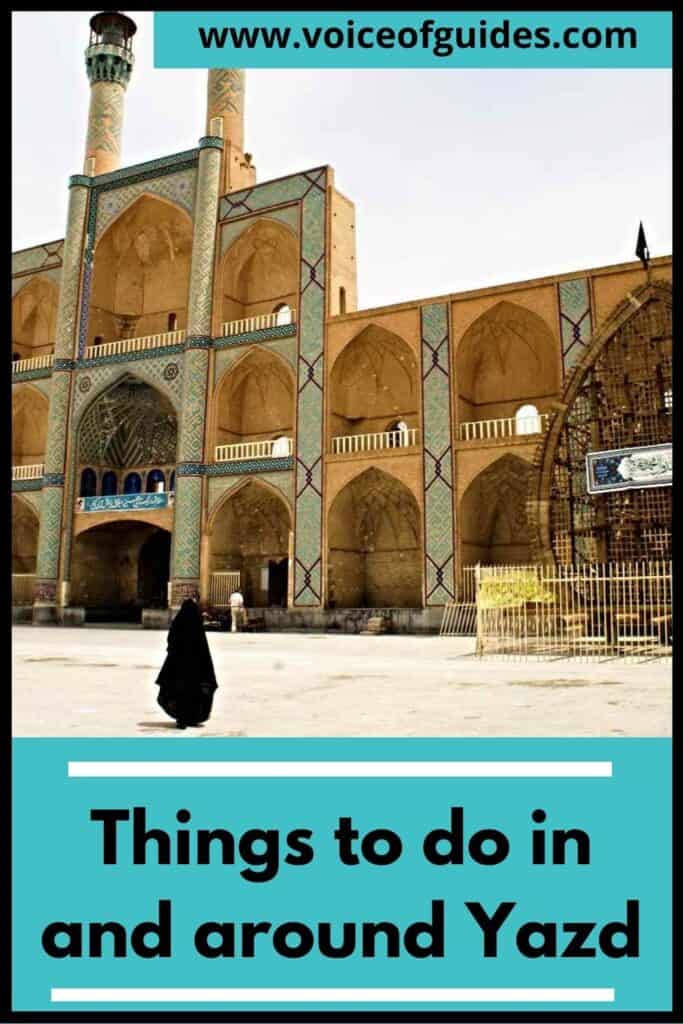
Yazd, the Zoroastrian center in Iran
Together with the surrounding villages, it is one of the principal centers of the pre-Islamic religion, Zoroastrianism. Zoroastrians make up 5-10% of the population in the predominantly Shia Muslim city. There used to be a larger Jewish community, but many of them moved to Israel. (The former Israeli President Moshe Katsav also came from Yazd.)
Here, the followers of the first monotheistic world religion survived the spread of Islam. After the Arab occupation of Iran, many Zoroastrians moved to Yazd, where they could preserve their faith in return for paying taxes. Islam only gradually became dominant in the region.
Zoroastrianism still exists today, but with a declining number of followers. Half of the Zoroastrian people, estimated at 150.000-200.000, live in Bombay in India. The second-largest community of about 25,000 belongs to the Iranian cities of Yazd and Kerman. Apart from Iran and India, a few of them stay in Pakistan and Azerbaijan as well.
Ahura Mazda is the main God of the Zoroastrians. All their temples house have an eternally burning fire that is the symbol of God. That is why they also call them fire temples. Until today, there are several „fire temples” in the city and around.
The struggle between good and evil is at the heart of religion. Zoroastrian believers have the motto: do not think, speak, and act indecently! Besides, they have their own traditions for marriage, burial, and religious festivals. They are also known to highly respect the four elements: earth, fire, water, and air.
Desert architecture in Yazd
Yazd lies in the desert and is the driest city in the country. It is unique for its desert architecture, which adjusts to the extreme temperature. It goes up to 60 degrees in summer and drops to 0 degrees in winter. Towers, domes, mosques, and wind catchers dominate the skyline.
The chimney-like wind towers pierced at the top are ventilation chimneys, the ancestors of air conditioning. The old town is a UNESCO World Heritage Site, and any construction in this area must follow a similar, traditional style. The houses were made of a special “sarooj” mortar, with goat and camel hair mixed into it.
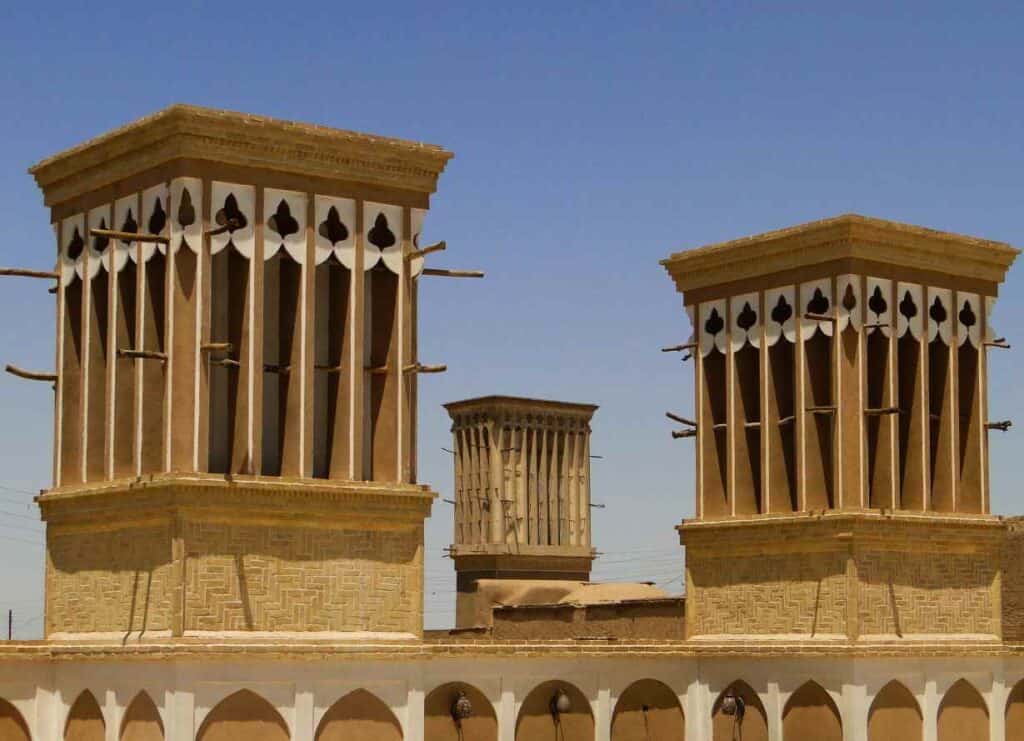
The qanat (water canal system), wind catchers, cisterns, walls out of thick mudbrick, narrow alleys covered with alcoves, and underground rooms help to survive under these hot and dry circumstances. Behind the thick, gloomy, windowless walls, beautiful inner courtyards and ornate living rooms open up. This style of housing reflects Islamic traditions and served defensive purposes as well.
The water canal system (qanat) built inside and around Yazd is 100km long and one of the longest and oldest on earth. Presumably, the Persians developed the qanat technology at the beginning of the 1st millennium B.C., from where it slowly spread towards the West and East. It passes under the Friday mosque and several wells were connected to it.
Read more about the qanat system at the “Water Museum” section.
Best things to do and place to visit in Yazd?
Entrance fees: The below-listed entrance fees are from 2019 (before COVID times). By normal reopening, they are expected to change but the exact prices are not known for the moment.
Due to economic sanctions and the pandemic, prices of basic facilities and products tripled or quadrupled. It means that the entrance fees can significantly increase too.
1. Stroll among the adobe houses and narrow alleys in the old part of Yazd
The old town of Yazd is one of the oldest and most expansive cities built out of mudbrick, which remained almost entirely intact. You can observe all elements of the desert architecture: high walls, narrow alleys, and arches that were to give shadow. Water reservoirs to supply water to locals and wind catchers that cooled the air inside the houses combined with underground water canals.
There are several art shops, inner courtyards, and old houses converted into guesthouses and hotels. The old town is a UNESCO Heritage, and therefore all buildings must follow the ancient style. There is a hundreds-of-years-old mosque, a hoseiniyeh (place for Shiite mourning rituals), the tombs of Islam scholars, traditional public baths and old bazaars with art shops.
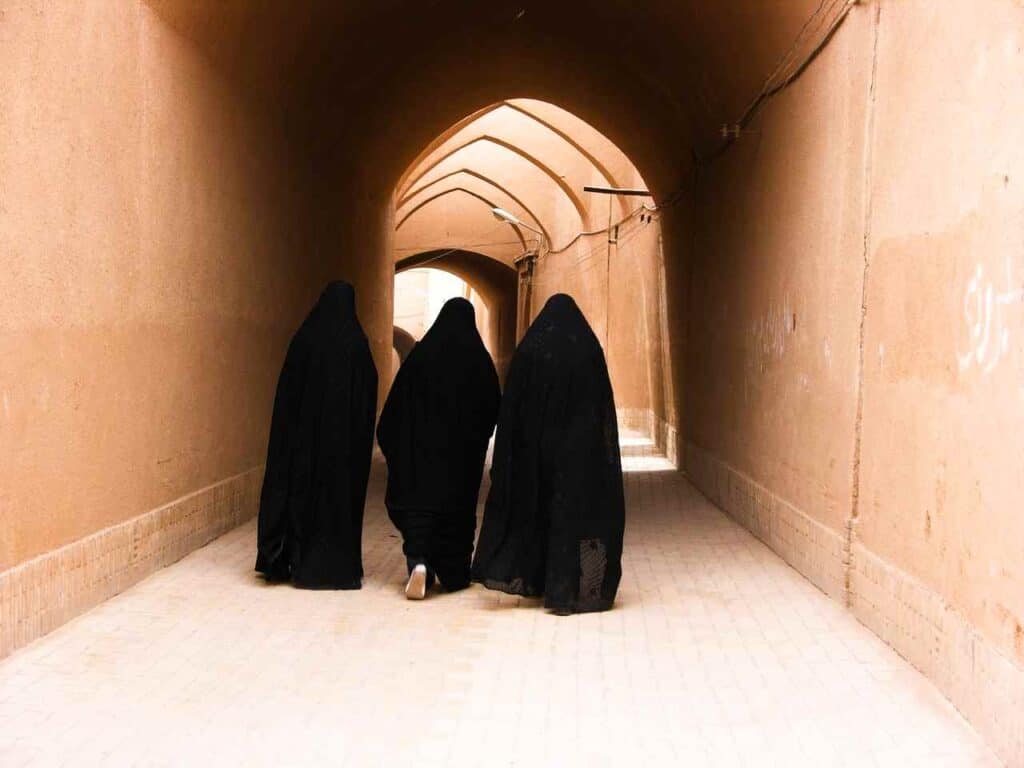
All the houses in the old town face the holy Islam city, Mecca. Therefore, the old part of the historic city of Yazd stretches from northeast to southwest.
Tip: Have a drink or a meal in one of the rooftop cafés with a stunning view of the city of wind catchers and domes.
2. Varahram fire temple in Yazd
There are several fire temples in Iran, but this is the only one housing Atash Bahram, the highest grade of fire (fire of victory). There are only nine of that in the world, eight of which are in India. This is a unique fire. 32 priests gather it from 16 different sources (lightning bolt, funeral pyre, kitchen hearth and furnaces) and perform certain rituals on them.
Above the entrance, you see the symbol of Zoroastrianism, the Farhavar. A bearded old man with wings holds a ring in one hand. It symbolizes loyalty, while the three layers of feathers refer to the path to be followed by Zoroastrian believers: Avoid thinking, talking, and acting indecently.
Inside the temple, you can see the 1000-year-old sacred fire behind a glass, where only Zoroastrian priests are allowed to go. They continuously keep the world’s oldest sacred fire alive. It represents Ahura Mazda, the Zoroastrian God.
Zoroastrians enter the temple barefoot in a white cloth and cover their heads. There are no sermons.
They only come to pray near the sacred fire and offer scented wood to the burning fire that is the only source of light inside the temple.
Opening hours: 7:30 am- 21:30 pm
Entrance fee: 150,000 IRR
Tip: There is a museum to the left of the temple that explains the birth of Zoroastrianism, their traditions and lifestyle. Do not miss that when you are in the temple.
Important: The temple gets especially crowded during Nowruz, the Persian New Year.
3. Tower of silence (Dakhmeh)
The tower of silence is part of the Zoroastrian death rituals. This unique structure stems from their belief that the corpse, deemed unclean, contaminates the four main elements: the fire, the water, the air, and the earth. Zoroastrians are well-known for highly respecting them. For that, they do not bury the dead body underground.
Instead, they place the corpse on the top of the towers, and it becomes the prey of vultures. The burial structures are usually outside the city at an inhabited place on the top of a hill. But since the 1970s, they no longer use it for funeral ceremonies. It turned into a tourist attraction by today.
The relatives bring the corpse to the tower. Then, it is the duty of the “nesakesh” to wash and carry it to the top. Up there, the “nesasalar” is watching over the corpse. Men are placed on the outer rim, women a little further inside, and children on the innermost part. The tower of silence is flat and wide on the top with a hole in the middle. They throw the human bones cleaned by the birds into the well.
When it gets full, they cover it with sand and stones. The rain washes and smashes the bones. The water disinfected with charcoal and acid gets discharged into the open air through underground channels.
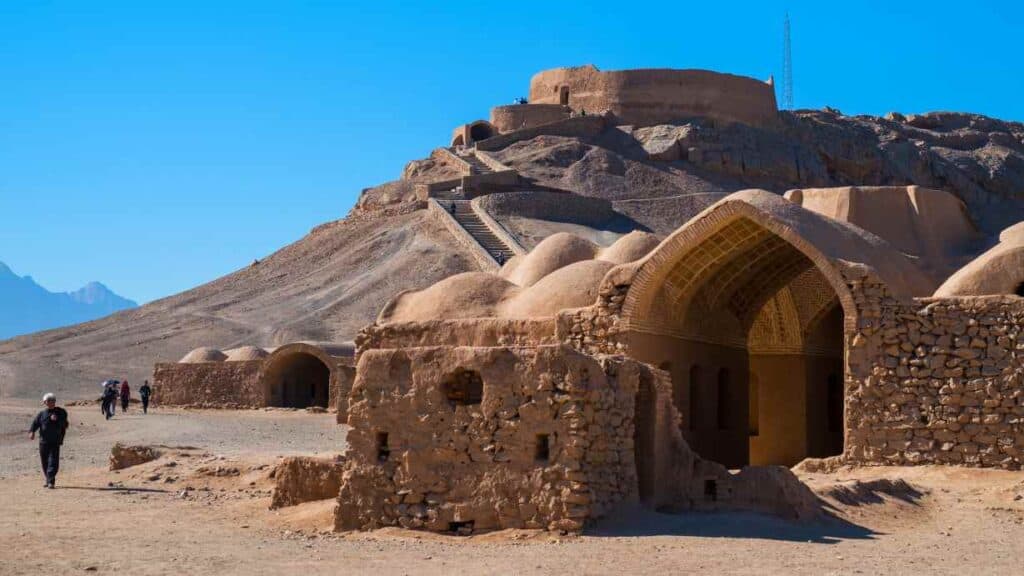
The men in charge of the dead body could never go to the city, and they could only marry women in a similar occupation. The last of them died a few years ago.
This method of burial was banned in Iran more than 40 years ago. Nowadays, Zoroastrians line the graves with stone slabs instead so that the body does not get in contact with the ground. In India, however, the old method is still partly used to this day.
This burial type came into practice later during the Sassanid dynasty between the 3rd and 7th centuries. Before that, Zoroastrians placed the body on the top of a mountain or hill. Then, they collected the bones and put them in holes inside the rocks. The great Persian rulers were an exception to this. Their tombs were cut high into the cliff in a cross shape and contained the ruler’s sarcophagus.
I highly recommend to include in your program when you visit Yazd.
Opening hours: 8:00 am- 5:00 pm
Entrance fee: 200,000 IRR
4. Friday Mosque
The Azeri-style Friday mosque from the 12th century encloses the blue-tiled gate with the tallest twin minarets of Iran at 52 meters.
It is a perfect example of the Persian blue-tile work of art and is one of the most well-known sites of Yazd.
Tip: The mosque is even more beautiful in the evening when it is illuminated.
Opening hours: Every day 8:00 to 19:30 in spring and summer except praying time
Every day 8:30 to 18:00 in fall and winter except praying time.
Entrance fee: 80,000 IRR for foreigner, free for Iranians
5. Amir Chakhmaq complex
At the center of the Amir Chakhmaq complex is a tekyeh, a Shiite gathering place where religious festivals, especially Ashura take place. The mourning during Ashura in Yazd is the most spectacular in Iran. The cypress-leaf-shaped wooden structure in the corner of the square plays a central role in the commemorations. They cover it with dark material and carry it on their back as a symbol of Hussein’s coffin. It is the biggest Shiite event during the year.
Amir Chakhmaq was the governor of Yazd in the 15th -16th century. Before, the complex included a caravanserai and a public bathhouse (hammam). The Dahouk mosque or Amir Chakhmaq mosque from the 15th century stands south of the Teqyeh. The facade consists of symmetrically built alcoves on three floors. In the past, it was possible to enjoy the view from the very top. Now you can only go up to the first floor.
Tip: Have a look at the shops of the traditional bazaar around Amir Chakhmaq.
Tip: Come back to the tekyeh in the evening when it changes its color and meet the locals. The open square in front of it is the most popular meeting place for locals.
6. Water museum – a fascinating introduction to the thousands of years old water supply system of a desert city
The water museum just opposite the Amir Chaqmaqh Complex was opened in a traditional merchant house with an inner courtyard and several underground levels.
The Qanat (underground canal) system has historically provided the water supply of Yazd. Surprisingly, many of the thousands of years old canal systems are still in use. A 75-km long canal crosses below the water museum so you can observe it yourself. Water supply was crucial in desert cities like Yazd. Persians were the first ones to master this technology that spread to other countries dealing with a desert climate.
A qanat is a very precisely designed canal system that pulls water from underground by the force of gravity. In the museum, you get an idea of under what difficult conditions the workers dug the small wells and underground canals. It was a complicated engineer’s work to calculate the gradient of the qanat and wells’ distance.
Its primary role is to provide sufficient water for irrigation, animals, and drinking water. In combination with wind catchers, it was also suitable for air ventilation.
The qanats crossed several wealthy houses that were interrupted with basement pools. The room close to the pool was ideal to get some cool air in the scorching heat and to store groceries.
The traditional water clock is one of the unique items of the museum. They used it to regulate the amount of water shared between different users.
Opening hours: 08:00 am – 7:00 pm
Entrance fee: 150,000 IRR
7. Dolat Abad Garden
It is one of the nine Persian gardens listed as UNESCO World Heritage in Iran. The external part was a venue for state gatherings, sports events, while the internal garden welcomes kings and other influential persons. The world’s tallest mudbrick wind tower in the center is the main attraction. The 33.8-meter-high octagonal tower serves as ancient air ventilation and is an incredible element of the desert architecture of Yazd. A 65-km qanat waters the garden.
Opening hours: 09:00 am- 11:00 pm
Entrance fee: 200,000 IRR
8. Watch the traditional Persian wrestling training, the Varzesh-e bastani (Pahlevani)
Watching the training of the ancient Iranian wrestlers in a Zurkhaneh (House of Strength) will be a highlight of your visit to Yazd. It is a combination of a religious ceremony and sports accompanied by music and praying. The Saheb-a Zaman Zurkhaneh near the Amir Chakhmaqh complex lets tourists come to see their training.
Open: Saturday- Thursday (shows at 5pm, 6.30pm and 8pm)
Entrance fee: 200,000 INR
9. Visit the oldest underground qanat system in the world in Zarch village – a top experience when you are in Yazd
It is where you get proof of why Persians are called the „masters of hydraulic engineering”. In Zarch village, 60 km from Yazd, you get access to the 3000-year-old underground canal system that still partly supplies Yazd with water. It starts in Fehraj village and ends in Zarch, while passing under Amir Chaqmaq and the Friday mosque. The steadily sloping canals carried the water from the mountains into the reservoirs of the city. More than 2000 sub-channels create a canal system of 80 km, one of the longest in the world.
How to get there: take a taxi for your visit.
Entrance fee: 150,000 IRR
What are the local specialties that you should try when you visit Yazd?
Shuli: one of the main dishes of Yazd, a vegetable soup made of beetroot, herbs, lentils, served with vinegar.
Gheymeh Nokhod: Yazdi style stew made with chickpeas, mutton, tomato paste, Omani lemon, saffron, potatoes, onions, turmeric, salt, and pepper.
Ash-e Anar: Persian pomegranate soup with meatballs
Ghottab: one of the famous sweets of Yazd (almond-filled, deep-fried Persian pastry)
Loz: similar to Baklava, made with different flavors: pistachio, saffron, almond, and coconut.
Baklava Yazdi: compared to traditional Baklava, the Iranian version is lighter, contains cardamom and rosewater as well.
Pashmak: the Persian cotton candy.
Faloodeh yazdi: They make the Yazdi Fallodeh from strands of starch and serve it with water, rose, and sugar syrup. It is not frozen, but they add ice to quench it.
The famous Haj Khalife Yazdi confectionery is the best place to try the Yazdi sweets. But be careful. There is a Haj Khalife Yazdi shop at both corners of Amir Chakhmaq Square. If you face the monument, choose the one on your right. The other one gained a bad reputation due to the lack of hygiene.
Recommended tours in Yazd
1. Cook with the Zoroastrians
2. Zoroastrian tour in Yazd and Taft
3. A night program to watch the stars of Taft from the top of the surrounding mountains chatting around the fire
4. A day-tour to Chak Chak- Meybod- Kharanaq – highly recommended!
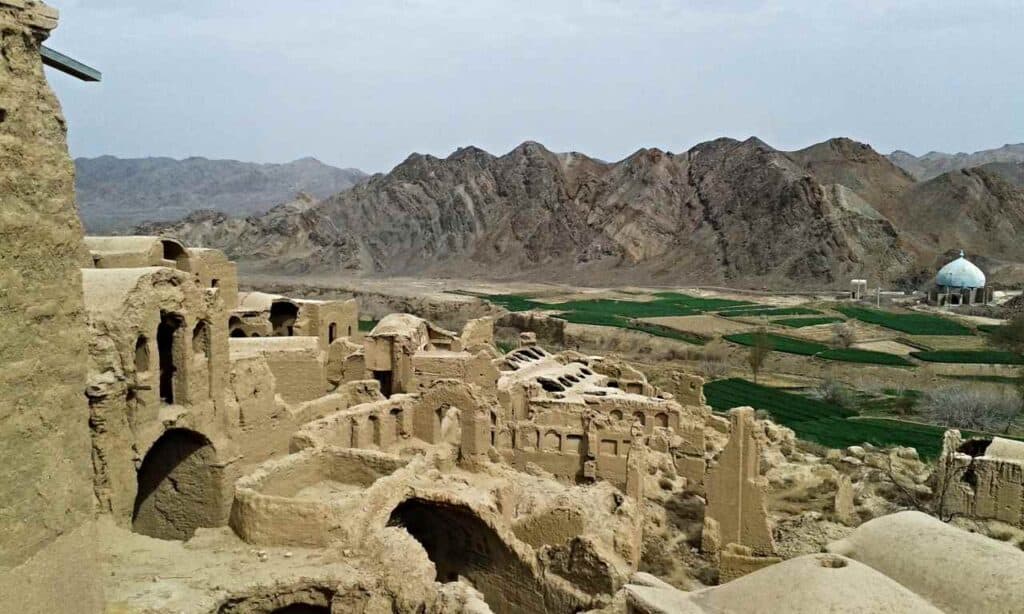
You should spend one day visiting only the sights around Yazd. Since it is troublesome to cover all of them if you are traveling independently, the easiest and cheapest way is to go on a day tour:
- Chak Chak: The principal Zoroastrian religious place with a fire temple up in the mountains. Inside the grotto, there is a constant dripping from the roof, hence the name “drip, drip”. You will learn about the local legend behind it.
- Meybod: The 2000 years old mudbrick Narin fort and the Kabutar Khaneh (pigeon house) are great stops in the desert city.Theunique 200-year-old structure attracted thousands of birds for the collection of guano. In the lack of chemicals, it was a precious commodity.
- Kharanaq: a 4500-year-old mudbrick village
You can sign up for this tour the day before in the Kalout hostel.
Where to sleep in Yazd
Silk Road hotel (1 star): This traditional hostel is a popular choice for tourists next to the Jame Mosque with private rooms and dormitory (Address: No. 5, Tal-e Khakestari Alley, Masjed Jame Street, Yazd)
Kalout hostel: Almost opposite the Silk Road. A traditional hotel with similar low-budget accommodations with private rooms and dormitories.
Al-Zahra (2 stars): Address: Farhangian Crossroads, Pakenjad St., Yazd
Fazeli (3 stars): Address: Vaght-o Saat sq, Masjed Jame Street, Yazd
Dad (4 stars): Amazing atmosphere, a nice hotel close to downtown built in a historical style (Address: No. 214, 10th of Farvardin St., Beheshti sq, Yazd)
Moshir AL-Mamalek Garden hotel (4 stars): Amazing Persian-style hotel with a pleasant garden and charming rooms. (Address: Moshir Al-Malak Blvd., Enghelab St., Yazd)
Safaieh (5 stars): Address: Fallahi St., Abuzar sq, Yazd
Recommended Restaurants in Yazd
Restaurant of Moshir Al-Malik Hotel Address: Moshir Al-Malak Blvd., Enghelab St., Yazd
Khan Dohad Restaurant Address: Sangrizeh Alley, Asizadeh Boulevard, Yazd
Fooka Cafe and Restaurant Address: Masjed Jame St., Yazd
Sezar Restaurant Address: The beginning of Sonbol alley, Abuzar sq, Yazd
Silk Road Hotel Restaurant Address: No. 5, Tal-e Khakestari Alley, Masjed Jame St, Yazd
As you can see there are plenty of things to do in and around Yazd. One day you can visit the tourist attractions of Yazd and on another day the best thing to do is to go on a day tour to visit the villages and Zoroastrian religious places around Yazd.

